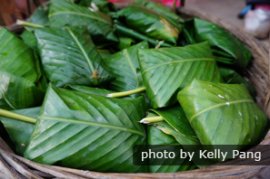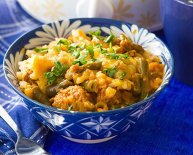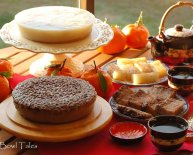
Chinese New Year sweet rice cake recipe
 New Year cakes
New Year cakes
The pronunciation of niangao sounds like 'year high' (年高), which symbolizes a higher income, a higher position, the growth of children, and generally the promise of a better year. niangao was originally used as an offering in ritual ceremonies before it gradually became a Spring Festival food.
- Chinese: 年糕 niángāo /nyen-gaoww/ 'year cake'
How 'Year Cake' is Made
niangao is usually made from glutinous rice flour, wheat starch, salt, water, and sugar. It is delicious when steamed, fried, or even eaten cold. Many people in rural areas still observe this ancient method to make New Year cakes:
- First, put some steamed rice into a big stone container.
- Second, beat it with a long-handled wooden hammer until the rice becomes a glutinous paste.
- Then take the paste out, cut it into small pieces (about 150 grams per piece).
- Lastly, roll them out into 3-centimeter-wide strips.
niangao Types
Within the extensive land of China, customs vary in different areas: white rice cake is eaten in north China, yellow rice cake in the northern frontier of China, water-mill-made rice cake in southern China, and hongguigao (红龟糕 'red turtle cake') in Taiwan.
The flavors of Niangao can be divided into two major kinds:
- Sweet rice cake is usually made in northern China by steaming or frying.
- In southern China, niangao can be sweet or savory, cooked by steaming, sliced-frying, or even cooking in soup.
Beijing New Year Cake
In Beijing, New Year cakes are on sale in many snack shops, like Qianmen Snack Street and Jiumen Snack Shop, especially during the Spring Festival.
Guangdong niangao and Hainan niangao
New Year cake wrapped in bamboo leaves in southern ChinaGuangdong niangao is often like a soft, sticky dough, made from glutinous rice flour, peanut oil, and shelled melon seeds, and wrapped in bamboo leaves. Rice cakes made in this way taste soft and sweet.
Hainan New Year cakes are made before the Spring Festival as gifts to share, with glutinous rice flour, sugar, sesame seeds, red dates and water as the main ingredients. There are some special ways to enjoy Hainan niangao, such as frying, baking, and boiling.
Jiangsu niangao and Zhejiang niangao
 In Jiangsu and Zhejiang (the Yangtze Delta area) choices of New Year cake fillings include sweet-scented osmanthus flower sugar, lard oil, and sweet red beans. In Zhejiang, the most common 'year cake' is Niningbo niangao, made from rice which has been crushed in a water mill.
In Jiangsu and Zhejiang (the Yangtze Delta area) choices of New Year cake fillings include sweet-scented osmanthus flower sugar, lard oil, and sweet red beans. In Zhejiang, the most common 'year cake' is Niningbo niangao, made from rice which has been crushed in a water mill.
'Year Cake' History
niangao has a history of at least 1, 000 years. Early in the Liao Dynasty (907–1125) people in Beijing had the custom of eating New Year cakes on the first day of the first month of the lunar year. During the Ming Dynasty (1368–1644) and the Qing Dynasty (1644–1911), niangao had already become a common folk snack, and remains so today.
The Niangao Legend
niangao has a legend about its supposed Suzhou origin, around 2, 500 years ago.
In the Spring and Autumn Period (722–481 BC) of ancient China, the whole country was divided into different small kingdoms and people suffered from the chaos of war. At that time, Suzhou was the capital of the Wu Kingdom. Strong walls were built to protect Wu from attacks, and the king held a banquet to celebrate their completion.
All of the people ceased to worry about the war, except for the Prime Minister Wu Zixu (伍子胥). He told his entourages: "War should not be viewed lightly. The strong wall is a good protection indeed, but if the enemy state besieges our kingdom, the wall is also a hard barrier to ourselves. In case things really go badly, remember to dig a hole under the wall."
Many years later, after Wu Zixu passed away, and his words came true. Many people starved to death during the seige. The soldiers did what Wu Zixu told them before and found that the wall under the earth was built with special bricks made from glutinous rice flour. This food saved many people from starvation. These bricks were the supposedly original niangao.
After that, people made niangao every year to commemorate Wu Zixu. As time passed, niangao became what is now known as Chinese New Year cake.
Tips on Eating niangao
niangao is made from glutinous rice and high levels of sugar. It is high in calories, and may be bad for you if over-consumed. Therefore you should not eat too many New Year cakes, especially if you suffer from obesity, diabetes, or high bloood pressure.




















